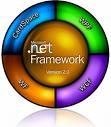.NET Framework:: Basics
I am posting some basic questions on .NET Framework which will help the beginners.
1- What is .NET framework?
Ans :
Wiki defines
“The Microsoft .NET Framework is a software component that is a part of modern Microsoft Windows operating systems. It provides a large body of pre-coded solutions to common program requirements, and manages the execution of programs written specifically for the framework.”
Another one
A programming infrastructure created by Microsoft for building, deploying, and running applications and services that use .NET technologies, such as desktop applications and Web services. It provides a highly productive, standards-based, multi-language environment for integrating existing investments with next-generation applications and services, as well as the agility to solve the challenges of deployment and operation of Internet-scale applications.
.NET Framework consists of 3 main parts :
- Common Language Runtime,
- .NET Framework class library,
- ASP.NET
2- What is CLR?
Ans :
CLR stands for Common Language Runtime. It is the implementation of CLI, Common Language Infrastructure which defines the execution environment for program code. The role of CLR starts after the compilation of the code written in the different languages by their respective compilers. The compiler converts the code into the CIL(Common Intermediate Language). The CLR’s just-in-time compiler converts this CIL code into the native code specific to the operating system at runtime. The CLR also provides other important services including:
- Memory Management,
- Thread Management,
- Exception Handling,
- Security,
- Garbage Collection
3- What is CLI?
Ans:
This is the main component of .NET framework. CLI stands for Common Language Infrastructure. CLI is a “specification” which defines an environment that allows multiple high-level languages to be used on different computer platforms without being rewritten for specific architectures. The implementation of CLI is known as CLR, Common Language Runtime. CLI describes four aspects:
- Common Type System (CTS),
- Metadata,
- Common Language Specification (CLS),
- Virtual Execution System (VES)
4- What is MSIL?
Ans:
MSIL stands for Microsoft’s Standard Implementation Language. Now it is known as CIL, Common Intermediate Language. This is the bytecode formed after the compilation of the program code.
5- What is CTS?
Ans:
CTS stands for Common Type System. It is a part of CLI. The .NET framework supports type definitions which are independent of any specific programming language, and CTS covers a range of topics related to type handling. These topics include type safety, cross-language sharing of typed data, type behavior and features, and performance.
6- What is JIT compiler?
Ans:
JIT stands for Just-in-time compiler and is a part of the CLR. JIT compiler, at runtime, compiles the CIL (bytecode) into the native code specific to the operating system.
7- What is CLS?
Ans:
Common Language Specification is a set of basic language features needed by many applications. It helps enhance and ensure language interoperability by defining a set of features that developers can rely on to be available in a wide variety of languages.
8- What is VES?
Ans:
VES stands for Virtual Execution System. It provides an environment for executing managed code. It also gives the support for a set of built-in data types, defines a hypothetical machine with an associated machine model and state, a set of control flow constructs, and an exception handling model.To a large extent, the purpose of the VES is to provide the support required to execute the Common Intermediate Language instruction set.
9- What are .NET Assemblies?
Ans:
.NET Assemblies contain the intermediate CIL code. Assemblies are stored in the Portable Executable (PE) format. It consists of one or more files, but one of these must contain the manifest, which has the metadata for the assembly. The complete name of an assembly contains its simple text name, version number, culture and public key token.
I will continue with some more stuff on different topics.

Hi Asit,
It really helped me a llot in understanding the .NET framework and CLR.
Thanks for providing all these information in such a beautiful way.
keep going …
cheers,
Ajai
Thanks Ajai, I will try to keep my blogs full of informations.
Nice post !!
Giving lots of information about .net framework.
THANKS AJAI…its really helping me as i’ve my interview 2morow…..specifically for .NET Framework………